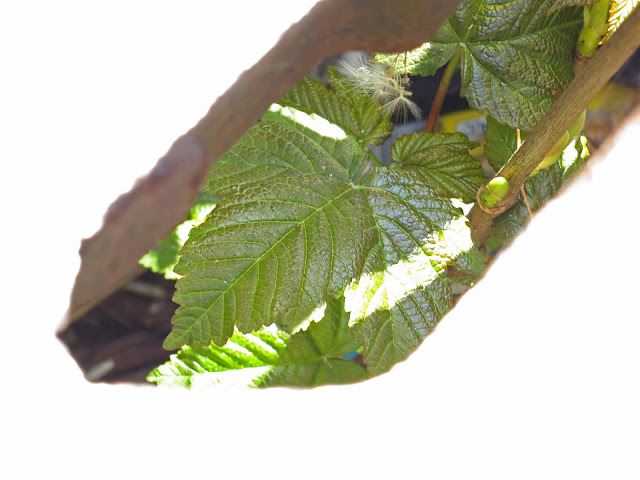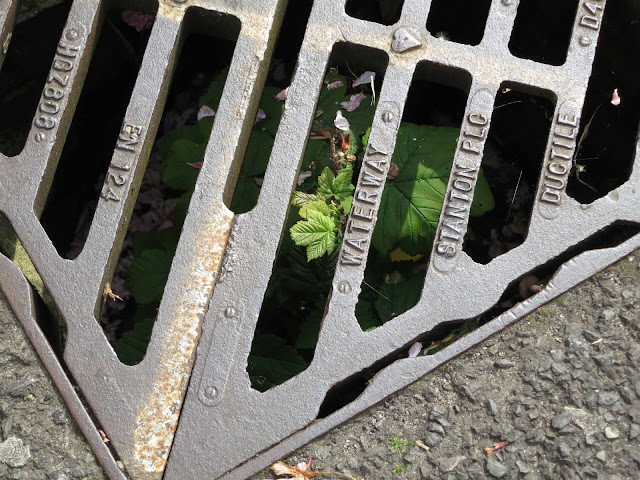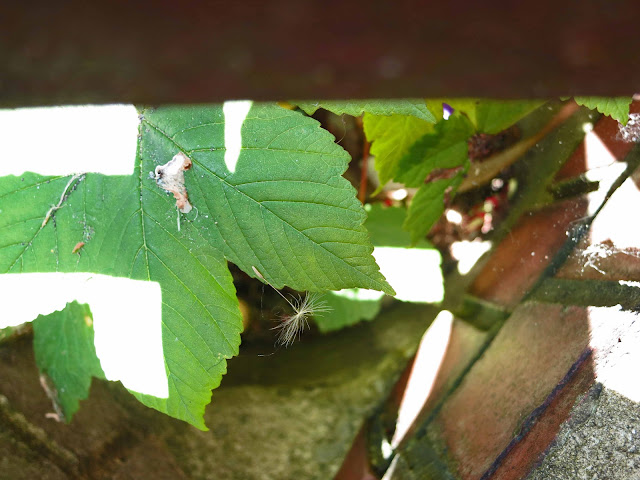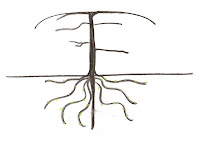 |
| March 1st 2012 |
Trees are generally unmissable . . . in the country they live in woods and forests and hedgerows. In towns they line streets or are neatly arranged in parks.
Paved, pedestrianised streets are not exactly leafy. Some have little squares cut in the ground with trees poking through. This street . . . spot the tree?
We have to look up to see it.
Trees underground are even less obvious. Finding them is, perhaps, a minority occupation.
But they are there.
 |
| April 16th 2012 |
Here is a sycamore in a drain. (Not in the shopping street above but in a residential street in a nearby town.)
 |
| May 2nd 2012 |
Perspective is difficult when peering with a camera into a drain. This tree begins about two feet underground and is not yet as close to the surface as it looks in the picture.
 |
| May 2nd 2012 |
 |
| May 22nd 2012 |
On its way up!
| May 22nd 2012 |
Larger leaves are maturing. Instead of rising above the dust of the street, dust from the street falls upon it.
| May 28th 2012 |
Up and over!
The photograph above is from today (May 28th 2012). The tree has begun to emerge from the drain and its leaves are under attack. If it were in a busy main road they would probably be smashed on first appearance. Cars are not gentle. Even in a quiet street it's unlikely this tree will be allowed to grow too tall - which is why I am posting this now. Let's celebrate it while it's there!
 |
The Latest Posts
from
Tree Followers
(Let me know if you have a new post to go in the List)
Patio Patch - Wych Elm: Worth the Wait in Gold
Experiments with Plants - London Plane Tree Gardening Ways - Plane Tree is Go!
Lichfield Lore - Tree Following in Theory - Cider Orchard
Down by The Sea - Visit to the Willow 5
Flighty's Plot - Butterflies, Dandelions and Trees
On the Edge Gardening - Copper Beech and Lime Together
For a list of the Tree Followers
And - don't forget Treeblogging which aggregates posts about trees from a wide range of blogs. |
16 comments:
Hi Lucy - Very observant of you to notice it in the first place. Thanks for giving this little tree it's moment of glory.
I would like to join the tree followers. This is the second post I've written about a much loved london plane tree : http://experiments-with-plants.blogspot.co.uk/2012/05/london-plane-tree-26-may-2012.html
You never ceased to amaze me of how much you notice around you. I would never bother to look in a drain!
Sarah x
Very well spotted - I find a lot growing from chimneys.
Lovely post, almost poetic about this resilient tree growing in such an adverse condition. It's life span may be limited but certainly still worth celebrating!
Sycamores grow with amazing speed and with the seeds being spread by the wind they turn up in all sorts of unexpected places as do many other trees. I suspect that the one in the drain will be removed once the council become aware of it as the roots will damage the drain eventually.
As observant as ever - poor doomed sycamore seedling - they can be a bloomin' nuisance though and a devil to remove once established. In a village near us there is an elder tree growing in a chimney pot - it has been there for years but doesn't seem to get any bigger. A bit of a tourist attraction.
In your first picture I could see the shadow, is it a Buddleia? I expect that the Sycamore would cause a deal of damage to the drain, but what tenacity it has!
As mentioned above, I love your ability to spot these little beauties when most people walk on by. It is a shame the Sycamore gets so much bad press. In my early years as a gardener, I was taught they were a weed tree and were to be removed at the earliest opportunity. Whilst (because of their ability to reproduce) they can be a nuisance, I've long since learned to appreciate their beauty and contribution. Long live Sycamore!
I marvel at how resilient trees are as they begin life choosing such harsh places to grow...here you can see them sprouting from roof gutters
Always appreciate your observant observations. Capturing the moments and felt the triumph of the tree making it through the boundary -for now at least
You are amazing to have noticed both trees. Even though it is physically closer, I probably would not have noticed the tree in the drain unless I stepped on it. Kudos to you for the photos and this eloquent post.
-- Bom@Plantchaser.com
Life can be so tenacious, even when doomed.
This article saddened me at first, realizing that you are right, in many cities and residential areas, there is not enough greenery in some parts of the world. Good eye finding it in that grate, let live!
-Oscar Valencia
Tree Service Queens
Fingers crossed for the sycamore. I just love it when plants manage to slip into hidden places. Near London Bridge station there is a light fitting low down and inside the glass casing a fern had insinuated itself. Humbling...
What a brilliant post. Well done for finding the tree in the drain too! I really like it when nature shows us that there's nothing we can do to prevent it from carrying on :)
Great post - my second favourite tree is the sycamore - have followed aphids and other insects on them for 20 years. Great survivors, very adaptable.
Post a Comment